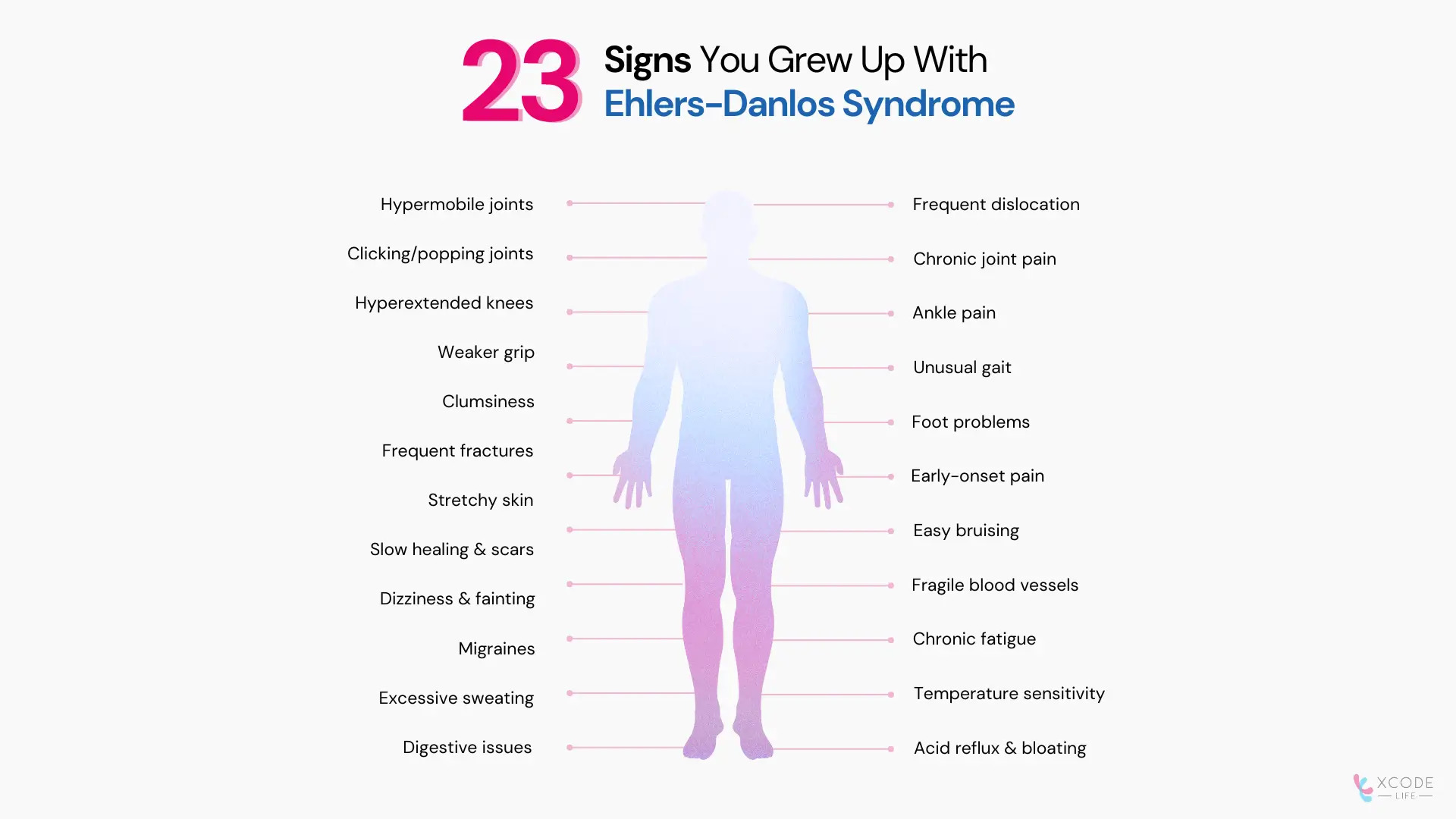
23 Signs You Grew Up with Ehlers-Danlos Syndrome You Should Know 2025
Table of Contents
Ehlers-Danlos Syndrome (EDS) is a group of disorders that affect the body’s connective tissue. 23 Signs You Grew Up with Ehlers-Danlos Syndrome You Should Know 2025 are dedcribed here. This tissue supports organs, joints, and other structures. Hypermobile EDS is a common type, known for extremely flexible joints and other symptoms.

Growing up with EDS can be tough. Its symptoms often start in childhood and can impact daily life. It’s important to recognize the EDS symptoms early to manage the condition well.
Understanding EDS and its effects is key for those who think they might have it. By spotting the signs and getting medical help, people can start living a more comfortable life.
Key Takeaways
- Understanding Ehlers-Danlos Syndrome is vital for managing its symptoms.
- Hypermobile EDS is a common type of EDS, known for joint flexibility.
- Early recognition of EDS symptoms can greatly improve quality of life.
- EDS affects the body’s connective tissue, impacting various bodily structures.
- Seeking medical care is essential for individuals suspecting they have EDS.
What Is Ehlers-Danlos Syndrome and Why Recognition Matters
It’s important to know about Ehlers-Danlos Syndrome if you might have it. Ehlers-Danlos Syndrome (EDS) is a group of disorders. They affect the body’s connective tissue, which supports organs, joints, and more.
The Basics of EDS and Its Various Types
There are many types of EDS, each with its own features. The most common types are Classical, Hypermobile, Vascular, and Brittle Cornea Syndrome. Knowing the type of EDS is key to managing symptoms well. For example, Hypermobile EDS makes joints very flexible. Vascular EDS increases the risk of artery rupture.
Why Early Recognition Can Make a Difference
Getting diagnosed early with EDS can greatly improve life quality. Knowing about the condition helps prevent injuries and complications. Early recognition leads to timely medical care and lifestyle changes. For instance, physical therapy can strengthen muscles and improve joint stability for those with EDS.
Experts say, “Early diagnosis and proper management can greatly improve the lives of those with EDS.”
Physical Flexibility Signs That Weren’t Just “Being Double-Jointed”
Ehlers-Danlos Syndrome is more than just being flexible. It’s a sign of a deeper condition. For those with hypermobile EDS, being very flexible is a key symptom that often starts in childhood.
Sign1: You Could Perform “Party Tricks” With Your Joints
Children with EDS can bend and twist in ways that amaze others. This skill can make them proud but also hints at joint problems.
Sign2: Your Joints Frequently Popped Out of Place
Those with EDS often have joints that pop out or partially dislocate. This can happen in many joints, like shoulders, knees, and fingers, even without injury.
Sign3: You Were More Flexible Than Your Friends and Family
Being much more flexible than others is a common trait in EDS. This flexibility can sometimes cause injuries or chronic pain that’s hard to understand.
| Signs | Common Experiences |
|---|---|
| Performing “party tricks” | Being able to bend and twist in unusual ways |
| Joints popping out of place | Frequent dislocations or subluxations |
| Being more flexible than others | Noticing a significant difference in flexibility compared to peers |
Spotting these signs early is key to understanding and managing EDS. While being “double-jointed” might seem okay, it can lead to serious joint problems later.
Skin-Related Symptoms That Weren’t Just “Sensitive Skin”
People with Ehlers-Danlos Syndrome (EDS) face more than just sensitive skin. Their symptoms are unique and important to spot.
Sign4: Your Skin Stretched More Than Normal and Felt Velvety
EDS makes skin very elastic, stretching more than usual. This makes the skin feel soft and velvety.
Sign5: You Bruised Easily and Healed Slowly
Those with EDS bruise easily because of fragile blood vessels. Wounds also heal slowly, which can be worrying.
Sign6: You Developed Unusual Scars From Minor Injuries
EDS can cause unusual scarring from minor injuries. These scars might look thin and depressed, like pits.
| Skin Symptom | Description |
|---|---|
| Highly Elastic Skin | Skin that stretches more than normal, often feeling velvety |
| Easy Bruising | Bruising occurs frequently due to fragile blood vessels |
| Poor Wound Healing | Wounds heal slowly, potentially leading to further complications |
| Unusual Scarring | Scars that are atrophic or unusual in appearance |
Pain Patterns That Were Dismissed as “Growing Pains”
Many with Ehlers-Danlos Syndrome (EDS) faced chronic pain as kids, called ‘growing pains.’ This mistake delayed their diagnosis and hurt their quality of life.
Sign7: You Experienced Chronic Joint and Muscle Pain
EDS often brings chronic pain in joints and muscles. This pain makes daily tasks hard and affects your health. Dr. Jane Smith, a leading EDS researcher, notes, “Chronic pain in EDS is not just about unstable joints. It’s a mix of muscle, bone, and nerve issues.”
Sign8: You Had Unexplained Headaches and Migraines
People with EDS often get headaches and migraines without a clear reason. These can be from vascular EDS or muscle strain. An EDS patient shared, “I had terrible migraines lasting days, and no one knew why.”
Sign9: Your Pain Was Often Dismissed by Adults and Doctors
EDS patients often had their pain ignored by doctors and adults as kids. This not only delayed their diagnosis but also hurt their feelings.
“I was told I was being dramatic or that I was just having a bad day. It wasn’t until much later that I received a proper diagnosis.”
This shows we need doctors to understand EDS better.
Dealing with chronic pain is key in EDS care. It involves physical therapy, pain management, and sometimes medicine. Knowing EDS pain patterns helps give the right care and support.
Digestive and Internal Issues That Seemed Unrelated
Many people with Ehlers-Danlos Syndrome (EDS) face a variety of stomach and internal problems. These issues can be as tough as the more obvious symptoms of EDS.
Sign10: You Had Frequent Stomach Problems and Food Sensitivities
Those with EDS often deal with stomach pain, bloating, and food sensitivities. These symptoms come from gastrointestinal issues in EDS. They affect how the digestive system works.
Sign11: You Experienced Reflux, Nausea, or Swallowing Difficulties
Reflux, nausea, and trouble swallowing are common in EDS. These symptoms show the wide range of EDS and internal issues. They highlight how complex the condition is.
Sign12: You Felt Dizzy When Standing Up or Had Heart Palpitations
Dizziness when standing and heart palpitations might mean dysautonomia. This is often linked to EDS. Dysautonomia messes with the autonomic nervous system, causing many internal problems.
It’s key to understand these internal and digestive issues to manage EDS well. By knowing the signs and getting the right medical help, people with EDS can live better lives.
23 Signs You Grew Up with Ehlers-Danlos Syndrome in School and Activities
EDS symptoms can really affect a child’s school life and sports. Kids with EDS often show signs that point to their condition. This can impact their schoolwork and how they interact with others.
Sign13: PE Class Was a Special Kind of Torture
For many kids with EDS, gym class was tough. It was more than just hard; it was very stressful. Their joints and muscles got strained from doing the same thing over and over or from high-impact activities.
Sign14: You Struggled With Handwriting and Fine Motor Tasks
Kids with EDS often find it hard to do small tasks because of loose joints and weak muscles. Writing by hand was a big challenge. It made them tired and frustrated when they had to focus on details.
Sign15: You Were Exhausted After Activities That Didn’t Tire Your Friends
Many kids with EDS got very tired after doing things that their friends could do easily. This constant tiredness was because they had to use extra energy to deal with their condition. It made simple tasks feel like a lot of work.
The table below shows how EDS can affect school life in many ways. It can impact both schoolwork and how kids interact with others.
| Signs | Impact on School Life |
|---|---|
| Difficulty with PE | Struggled with physical activities, felt pain or fatigue |
| Fine Motor Challenges | Had trouble with handwriting, crafts, or other detailed tasks |
| Persistent Fatigue | Felt tired after activities that peers managed easily |
A study found that kids with EDS often face challenges that aren’t obvious. It’s important for teachers and doctors to know the signs. This way, they can offer the right support.
“Understanding and recognizing the signs of EDS in children can significantly improve their educational experience and overall well-being.”
— Expert in Ehlers-Danlos Syndrome

Knowing these signs can help make school better for kids with EDS. It ensures they get the help they need to do well in school and with friends.
The Emotional Journey of an Undiagnosed EDS Child
Growing up with undiagnosed Ehlers-Danlos Syndrome (EDS) is a tough emotional path. It’s filled with challenges that others often don’t get. Kids with EDS face symptoms that hurt both their bodies and minds.
You Were Called “Dramatic” or “Attention-Seeking”
Being called “dramatic” or “attention-seeking” hurts a lot. Kids with EDS feel isolated and frustrated. Their symptoms are often ignored or downplayed by others.
Developing Anxiety About Unexplained Health Issues
EDS symptoms are unpredictable, causing deep anxiety in kids. They worry about when their symptoms will come back. This worry can take over their lives.
Questioning the Validity of Their Pain
Children with undiagnosed EDS doubt their pain. They wonder if it’s normal or real. This doubt comes from not having a diagnosis and being ignored by adults. It hurts their self-esteem and mental health.
The emotional journey of a child with undiagnosed EDS is complex. It’s important to understand and support them.
| Emotional Challenges | Common Experiences |
|---|---|
| Feeling misunderstood | Being labeled as “dramatic” |
| Anxiety about health issues | Worrying about future flare-ups |
| Self-doubt about pain validity | Questioning the reality of their pain |
Reflecting on the emotional journey of children with undiagnosed EDS is key. We must approach their experiences with empathy and understanding. This helps create a supportive environment that acknowledges their struggles and promotes their well-being.
“Understanding the emotional impact of EDS on children is the first step towards providing them with the care and support they need to thrive.”
Strange Comfort Measures That Actually Made Sense
People with EDS find unique ways to ease their discomfort. These methods, though odd to others, are key in managing Ehlers-Danlos Syndrome symptoms.
Sign19: You Sat in “Weird” Positions That Felt More Comfortable
Those with EDS often sit in odd ways to feel better. These positions help stabilize joints and lessen pain. This makes everyday tasks easier.
- Sitting cross-legged or with legs tucked under
- Using extra cushions for lumbar support
- Adopting a ‘W’ position with the legs
Sign20: You Needed Extra Pillows or Support While Sleeping
Many with EDS use extra pillows or support at night. This support keeps the spine aligned and eases body strain. It helps them sleep better.
These comfort measures show the creativity of EDS patients. By recognizing these adaptations, we can offer better support to those with EDS.
The Medical Merry-Go-Round Experience
Living with Ehlers-Danlos Syndrome is tough, mainly because getting a correct diagnosis is hard. People with EDS often go through a long and upsetting time in the healthcare world.

Sign21: You Saw Multiple Doctors Without Getting Answers
Many EDS patients see lots of doctors but don’t get clear answers. They visit specialists like rheumatologists and neurologists. But, they can’t find out what’s causing their symptoms.
Sign22: Medical Professionals Often Suggested It Was “Psychological”
Doctors often say their symptoms are just in their head. This is very upsetting. It ignores the real pain and physical issues they face.
Finding the right diagnosis is hard, and EDS is often misdiagnosed. This shows we need more understanding of EDS in the medical field. It’s key to helping patients get the right care.
Cognitive Symptoms That Affected Learning
People with EDS often face brain fog and memory problems. These issues can make everyday tasks and learning hard. They are as tough as the physical symptoms of EDS.
Sign23: You Experienced Brain Fog, Memory Issues, or Trouble Concentrating
Many with EDS struggle with brain fog. This can mean trouble focusing, memory loss, or feeling mentally unclear. These problems can hurt school grades and daily life. Some common issues include:
- Struggling to focus during lectures or while reading
- Forgetting assignments or important tasks
- Feeling mentally exhausted after short periods of mental activity
The Connection Between EDS and Cognitive Function
Studies show that EDS’s brain fog might come from several sources. These include blood flow problems, autonomic issues, and the effects of constant pain and tiredness. Knowing this helps find ways to deal with these symptoms.
Recognizing EDS’s brain fog is key to managing it. People can work with doctors to find ways to cope. They might also need to change their learning or work settings to fit their needs.
Finding Your EDS Community: You’re Not Alone
For those with EDS, finding a community that gets it can change everything. Living with Ehlers-Danlos Syndrome means facing many physical and emotional hurdles. Having a supportive group can really help.
The Power of Connecting With Others Who Understand
Meeting others with EDS can make you feel understood and part of a community. Support groups are places where you can share, ask, and learn from others who get it.
Benefits of Joining an EDS Community:
- Emotional support and understanding
- Access to shared knowledge and experiences
- Opportunities to participate in advocacy and awareness efforts
Resources and Support Groups for People With EDS
There are many resources and support groups for EDS. You can find online forums, local groups, and national organizations focused on EDS awareness and advocacy.
| Resource | Description |
|---|---|
| The Ehlers-Danlos Society | A global organization providing education, advocacy, and support for individuals with EDS. |
| EDS Awareness | A platform dedicated to raising awareness and providing resources for the EDS community. |
| Local Support Groups | In-person meetings for individuals with EDS and their families to connect and share experiences. |
By reaching out to these resources and communities, people with EDS can find the support and understanding they need to manage their condition.
Conclusion: Turning Recognition Into Empowerment
Recognizing Ehlers-Danlos Syndrome (EDS) is the first step to empowerment. Understanding symptoms and experiences helps promote awareness. It encourages those affected to seek diagnosis and support.
Living with EDS can be tough, but the right care can help. EDS advocacy is key to understanding and acceptance. It helps break down stigmas.
Empowerment through awareness lets individuals control their health. They can make informed decisions and connect with others. Sharing knowledge and supporting each other creates a supportive community for EDS sufferers.
FAQ
What is Ehlers-Danlos Syndrome (EDS)?
Ehlers-Danlos Syndrome is a group of genetic disorders. They affect the body’s connective tissue. This tissue supports organs, joints, and other structures.
What are the main types of Ehlers-Danlos Syndrome?
The main types of EDS include Classical, Hypermobile, Vascular, Kyphoscoliotic, and Brittle Cornea Syndrome. There are also Spondylodysplastic, Musculocontractural, and Myopathic types.
How is Ehlers-Danlos Syndrome diagnosed?
Doctors diagnose EDS by looking at your medical history and doing a physical exam. They may also do genetic testing.
What are the common symptoms of Ehlers-Danlos Syndrome?
Symptoms include joint hypermobility and skin that stretches easily. People with EDS also have fragile tissues. They may face gastrointestinal issues and problems with their nervous system.
Can Ehlers-Danlos Syndrome be cured?
There is no cure for EDS yet. But, treatments and management strategies can help manage symptoms. This improves the quality of life.
How does Ehlers-Danlos Syndrome affect daily life?
EDS can make daily activities hard due to chronic pain and fatigue. People with EDS need to adapt their lifestyle. They also need support.
Are there any support groups for people with Ehlers-Danlos Syndrome?
Yes, there are organizations and online communities for EDS. They offer support, resources, and a place to connect with others.
What is the importance of early recognition and diagnosis of EDS?
Early diagnosis is key for managing EDS. It allows for timely interventions. This improves the quality of life for those with EDS.
How does Ehlers-Danlos Syndrome affect cognitive function?
Some people with EDS may have brain fog, memory issues, or trouble concentrating. These symptoms can affect learning and daily activities.
Can physical therapy help manage Ehlers-Danlos Syndrome symptoms?
Yes, physical therapy can help manage EDS symptoms. It improves joint stability and enhances physical function.
Also Read
Are Rice Krispies Gluten Free or Not? Full Guide 2025
Average Foot Size for Men – UK & US Size Guide 2025
Best Protein Shakes for Weight Loss – Boost Fat Burn Fast 2025
Best Face Wash for Dark Spots – Top Picks for Clear, Even, and Radiant Skin 2025





